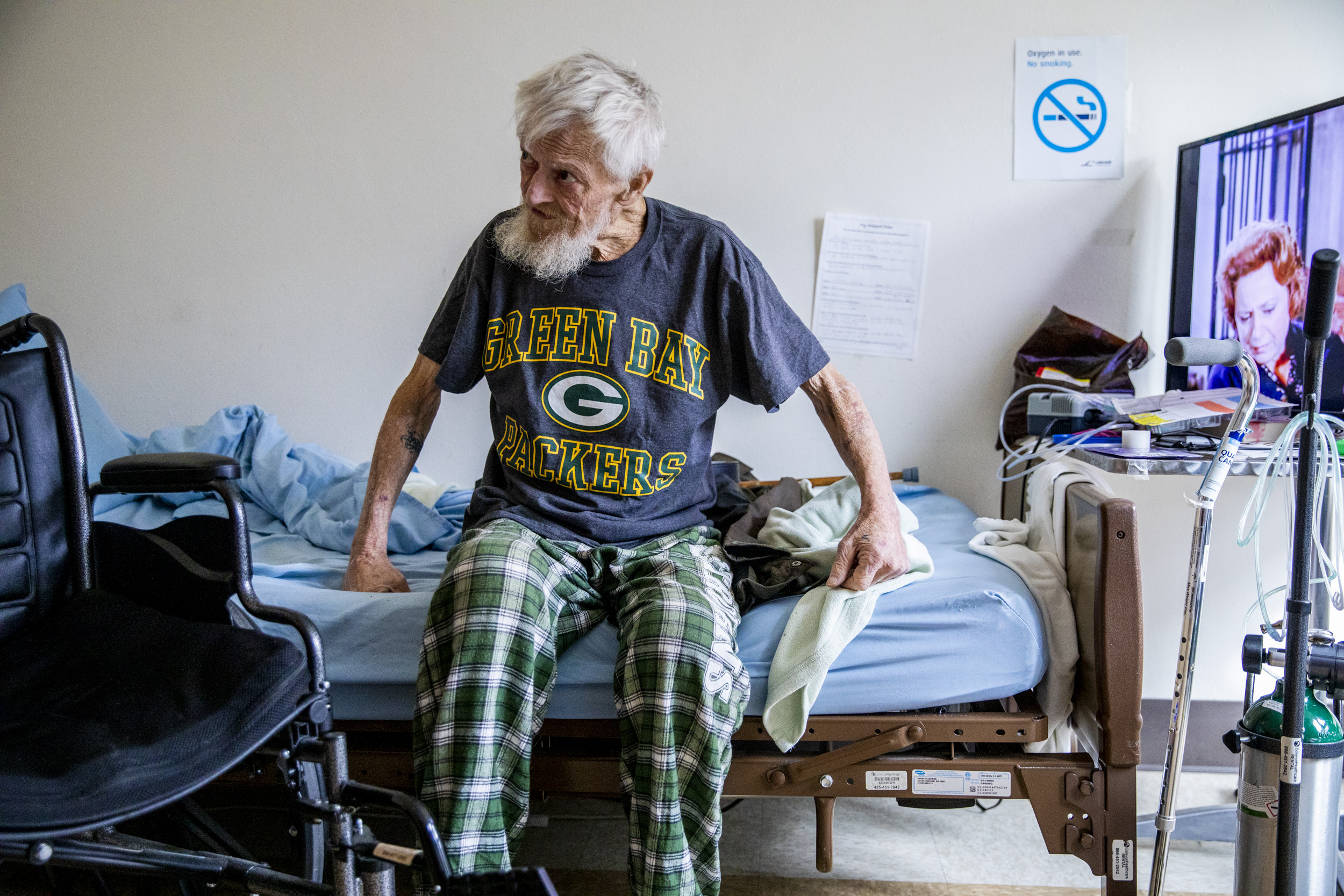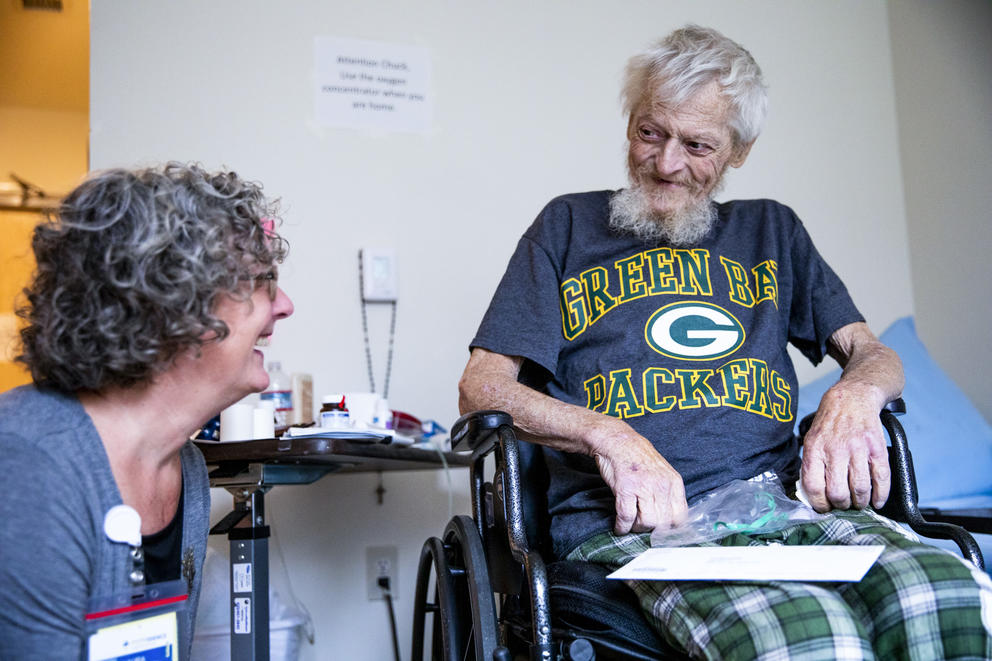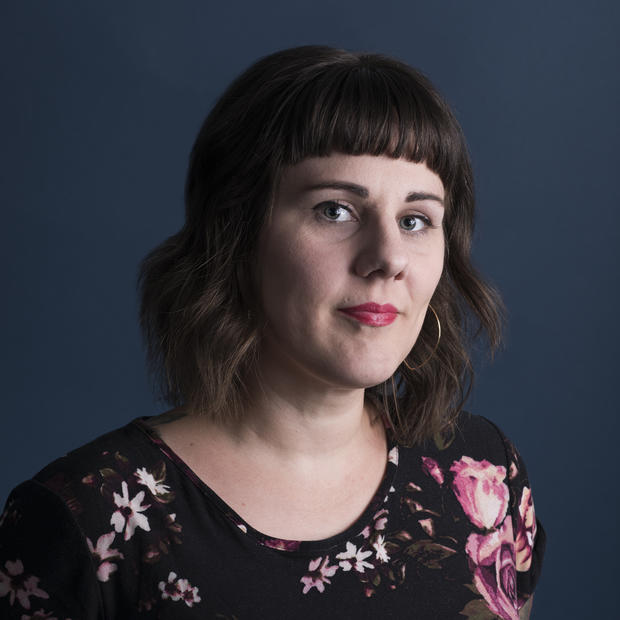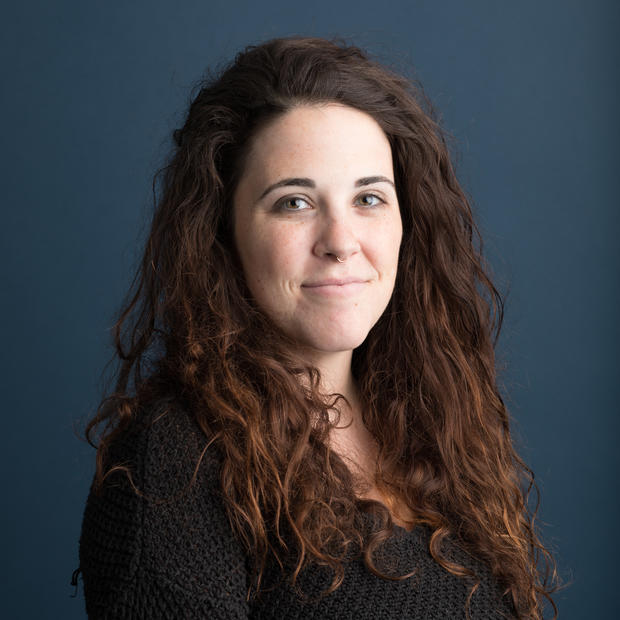Originally from Tacoma, he moved back to Seattle a year ago to be closer to his roots after years of traveling around the West Coast. He was living on the streets and battling illness. He had been in and out of the emergency room at Harborview and was suffering from pneumonia. Then a friend told him about Plymouth Housing, a nonprofit supportive housing facility that takes into account an applicant’s health status.
King, who is 68 years old, applied and was accepted into Plymouth. But shortly after settling into his studio apartment, King received a shock. He was diagnosed with heart failure and was told he had only six months to live. His doctor at Harborview provided him with a referral to hospice care, and soon he began receiving visits by a nurse from Providence Hospice of Seattle.
"In the beginning, it scared me because I thought I was going to die,” King said. “If it wasn't for this place right here, I'd probably be dead, because I was sick, very sick.”
With more than half of the nation’s homeless population over the age of 50, access to hospice care is a dire need. Without permanent housing, health issues are exacerbated, new illnesses develop and access to regular medical care is more difficult. Those experiencing homelessness are dying much sooner, from their 40s to early 50s, compared with an average life span of 78 for the population as a whole, according to a study from the University of Tennessee Health Science Center.
Washington’s homeless population currently ranks as the fifth highest in the country, and looking at King County in 2018, over one-third of the deaths (73 of 194) of homeless people resulted from natural causes. Emergency rooms, frequently the first stop in the health care system for the homeless, often will make the necessary hospice referrals. But where do they send someone without housing?
In 2018, Joshua's House opened in Sacramento, California, breaking ground as the first hospice care facility for the homeless on the West Coast and one of only a handful across the country. Washington has no such dedicated inpatient facility, but some organizations across the state are doing work to make the last months of the state’s homeless residents more comfortable and less lonely.
And while there are no state laws or regulations that ensure someone in hospice gets housing, there are a number of ways that hospice is provided to some people living in, or having recently moved out of, homelessness. Mobile teams of nurses and social workers work to meet the unique needs of these patients, whether that means visits to a van, a motel or a couch. Some hospice patients, like Chuck King, are lucky enough to receive housing.
Months after his end-of-life diagnosis, King said he is in pain almost constantly. In addition to heart failure, he also has been diagnosed with a slow-growing blood cancer. He has thought about suicide many times, he said. He also has battled with a substance abuse disorder most of his life. Injecting heroin into his legs has wasted away the muscles, he said, pointing at his thin limbs. He has a lot of regrets, he said.

But it’s like night and day since he’s come to live at Plymouth Housing.
At Plymouth, King has access to health care, social workers and substance abuse treatment. He goes on about the changes it has made to his life.
“The people here are so open, caring. I couldn’t speak enough about this program. It saved my life,” King says. “I was basically in the gutter; I was strung out. I was on my deathbed. They woke me with open arms, something I never had done to me.”
When he started hospice in July, he met his hospice nurse, Laura Newcomb. They have a close relationship. She moves comfortably around his studio apartment, joking about bribing him with watermelon to talk kindly about her.
“I can’t say enough about her. She’s a remarkable lady,” King said. “She calls it a team — if it’s a team, she’s definitely the captain. She’s made me stop and look at myself.”
Before his stay at Plymouth, King received much of his care from Harborview, which serves many of Seattle’s downtown homeless patients. The hospital provides about $80 million in uncompensated health care services annually. In 2017, 90% of Harborview's emergency department patients were homeless.
The hospital, located on Seattle’s First Hill, also has a mobile homeless palliative care team with three part-time workers: social worker Michael Light, registered nurse Joe Hufford and nurse practitioner Tony Boxwell. Palliative care provides medical planning, symptom management and social support for those with chronic or serious illnesses, but the team often refers their homeless clients to hospice care if the illness progresses.
Although the team focuses on palliative care, it will stay involved in the client’s life as they progress through hospice.
Although the number of clients constantly fluctuates, Light estimates the mobile team actively serves about 25 people at a time, 15 others on an inactive list where they might need future follow-up and upwards of 10 on a referral list. Of these, they have an average of five on hospice.
Homelessness itself is a life-limiting condition, he said.
“The risk of death is higher. People are more likely to die of common conditions that you and I might be able to get access to treatment for, whether that’s a chronic disease, cancer or an acute illness,” he said. “Folks without housing are at greater risk of morbidity and mortality.”
Light said an important part of the palliative care team’s jobs is to coordinate care to give context and history of the client’s needs to hospice teams. Health care systems can be inflexible for vulnerable populations, he said, and patients are at risk of being kicked out of inpatient facilities, as some can be “a little challenging and don't fit into an easy mold,” he said.
“We don’t think about people without housing [as] having histories and legacies. We tend to think about them most in the context of homelessness,” Light told Crosscut. “I try to bring a different view of patients to the table when we’re talking with providers and humanize someone’s experience.”
One of the team’s clients was Alvin Taliaferro, who was diagnosed with metastatic prostate cancer and referred to the palliative care unit. Artistry was a large part of Taliaferro’s identity, Light said, and he was skilled in many mediums of art, from woodworking to ceramics to jewelry making. It's a reason for him to keep living, said Light.
The palliative care team, staying with him through hospice, provided much more than medical care, giving emotional support and reigniting social connections. The team reconnected Taliaferro with his daughter and, after his passing, sent pieces of his art to his family. They had secured a storage unit during his homeless periods so that he could store his art.
They planned a showing of Taliaferro’s work, along with work by another former patient. Although Taliaferro passed before the viewing, the team was able to celebrate and remember the impact he made on others.
“We were able to tell the story of who he was, honor his life and share some of his work and send some of that work back to his family, too,” Light said. “Beautiful work that he made that would have been lost, would have been thrown out, instead it’s going to be distributed to those family members.”
Chuck King laughs with his hospice nurse, Laura Newcomb, in his apartment. Newcomb comes to visit King twice a week, and the pair have developed a close-knit rapport, often making jokes or teasing each other as she gives him medication or tends to his wounds. Newcomb says it is more like a team. “She’s got a loving heart and really cares about people,” King says. (Dorothy Edwards/Crosscut)
Newcomb, King’s hospice nurse, said much of her work is also more than medical.
Every patient’s care plan is different, she said, including King’s.
“Since he doesn’t have as much [family] support — he gets a ton of support from the facility — but he doesn’t have the family around the bedside that a lot of people do,” she said. “So a lot of what I do is talking to him, giving him support and encouragement [as well as] medication management, reminding him to eat, telling him not to fire people.”
She laughed at King’s cheeky behavior. He’s open to her about when he slips back into drug use, she said. When he starts to cry while recounting his battles with suicidal behavior, she said she comes to rub his back, asking if he needs a break.
King is one of 14 hospice clients Newcomb serves in the Queen Anne and Magnolia neighborhoods. Most of her clients have housing, but in addition to King, she also helps a patient who lives in a shelter.
The toll of hospice care can be overwhelming for her, she said, but she’s careful not to overcommit to work, taking breaks when she needs to. She goes on walks and gardens to keep her stress levels low. She said nursing as a profession is tough in itself and hospice is a rewarding path.
She has been a nurse since 1982, but returned from retirement a year ago to enter hospice work for the first time. It was a dream job, she said.
“It’s an honor to be in someone’s life so intimately,” she said. “I enjoy how close you can get to people [and] anything you can do to make people more comfortable for their families.”
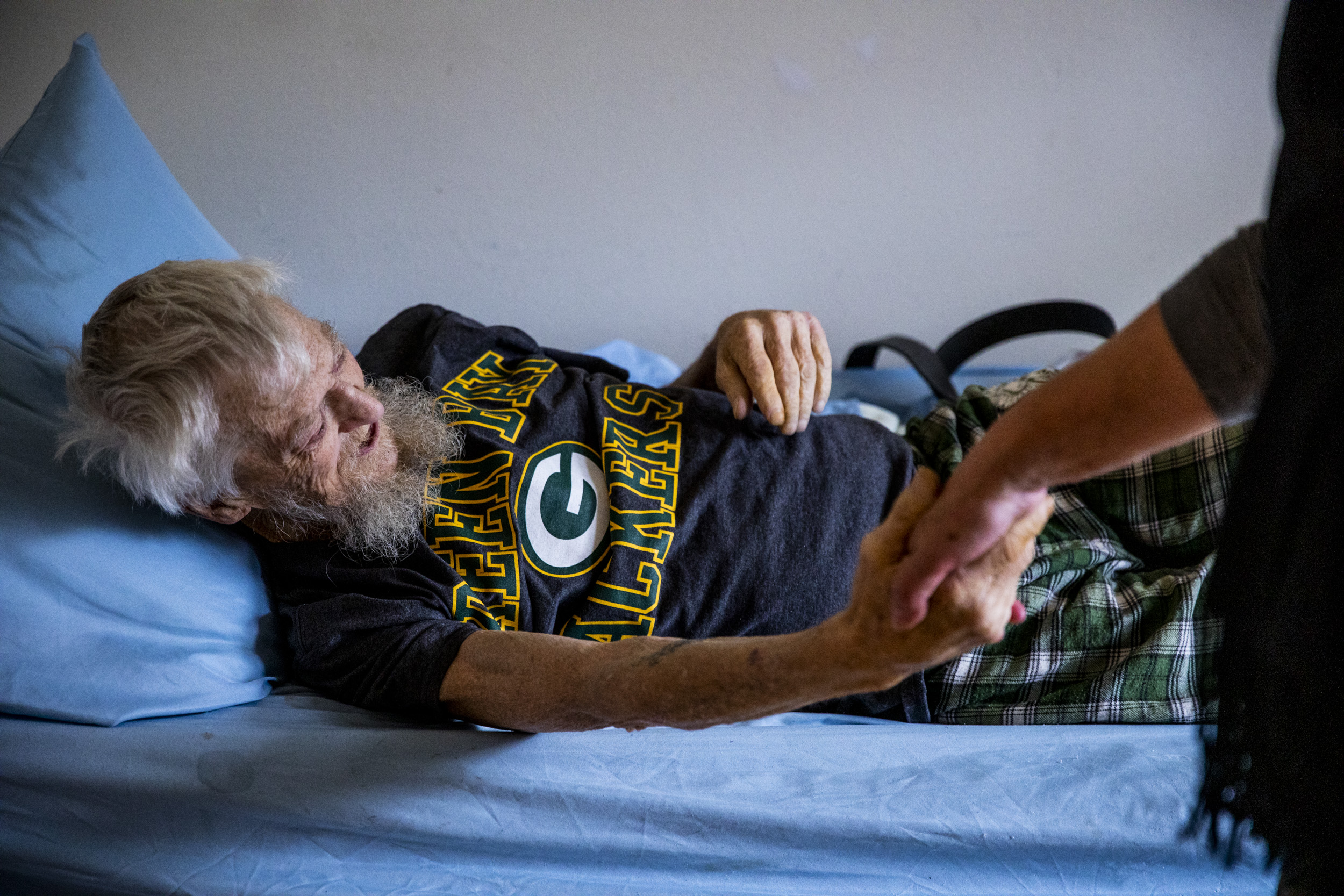
Franciscan Hospice and Palliative Care also serves the homeless in Seattle. Bonni Stratton is the manager of business development and has worked in hospice since she started volunteering 22 years ago.
While Franciscan doesn’t keep data on its clients’ housing status, Stratton said it probably has about six to seven homeless patients a year. However, she said, the number is most likely higher, as not everyone discloses whether their housing is temporary.
A recent patient was living at the Nativity House shelter in Tacoma and was referred to Franciscan for hospice, she said. Franciscan was able to place him at Hospice House, its 20-bed inpatient acute care facility for those in need of direct symptom management. Once the patient's pain was controlled, and no longer met the criteria to stay, Franciscan placed him in a hotel for several weeks, where it continued hospice care with visits from a CNA (certified nursing assistant), RN and social worker. He left their care when he moved to another county outside of Franciscan's service area.
Stratton said the hospital also made visits to a hospice patient with cancer who lived in his van. He was parked near a library, which the staff used as a larger space for visiting. They also used a nearby clinic for medical care.
The patient decided he wanted to stay in his van until the end. Doing so was important to his sense of self-autonomy, Stratton said. It is important for hospice care to be flexible, she added, as it is about meeting the patient’s needs and wants, not any preconceived notions of what hospice care should look like.
“That was a real successful situation with the van because that’s really where he wanted to be,” Statton said. “We work with the patient from the very time that we start, if they have insecure housing, to really work with them: Where do you want to have this [care] as things change, as you decline?”
King sings praises of his current housing. He’s happy to be off the street, taking a rest from bouncing around to different cities.
On his bad days, King isn’t very mobile. The pain is too excruciating, he said, even lying in bed. When Newcomb comes, it’s a welcome mental reprieve.
When he had better days, he went to baseball games or down to the waterside. He previously lived on the beach and said experiencing the ocean is the only thing that compares to a high. It’s intoxicating for him. It helps him to heal from his past and to feel better in the present. He recently had another surgery, but hopes to recuperate quickly.
“I’m hoping in another week I’ll at least be able to go walking down to the waterfront. I can spend the whole day there and watch the waves come in,” he said. “It’s so mind boggling for me. So peaceful.”
When he dies, King said, he wants to be laid to rest in Tacoma or Seattle. He talks animatedly about the city: The people he’s met, the “A pluses” he gives to Harborview and Plymouth Housing, the care he receives from Newcomb. Although he is in pain, he’s now surrounded by an integrated health care system that offers medical assistance and emotional support. His words speak volumes.
“She has a loving heart,” King said of Newcomb. He pauses. “She really cares about people and that’s hard to find nowadays.”
